译者主体性研究 On translator's subjectivity
研究生开题报告答辩

基本观点
二十世纪七十年代以来,翻译研究取得了极大 的发展,译者的主体地位及其主体性发挥等问 题得到学者们的广泛关注。在翻译活动中,译 者是积极的实践者、参与者与决策制定者,译 者是翻译的主体,译者的主体性发挥关系到 翻译的成功与否,关系到译文读者对信息的 接受与否。
创新之处
与单纯的从翻译策略、翻译方法角度去分析 某一题材的文本不同,在本篇论文中,笔者 试图从译者主体性的角度出发,去探讨译者 本人在翻译过程中所起的作业、制约因素, 最后给出与译者自身相关的可行性建议。
目的论视角下英汉科技英语翻译 中的译者主体性探究
On the Translator’s Subjectivity in E-C EST Translation From the Perspective
of Skopos Theory
选题依据及研究意义
选题依据: 1. 笔者自身在英汉科技英语翻译中
4.2.2 The Subject of Translation 4.2.3 The Subjectivity of Translation 4.3 Restrictions on the Translator’s subjectivity 4.3.1 The Type of the Source Text 4.3.2 Language Barrier 4.3.3 The Translator’s Competence
4.1 An Introduction to EST Translation 4.1.1 Features of EST Translation 4.1.2 Principles of EST Translation
4.2 Translator’s Subjectivity
论文框架
On+the+Translato...
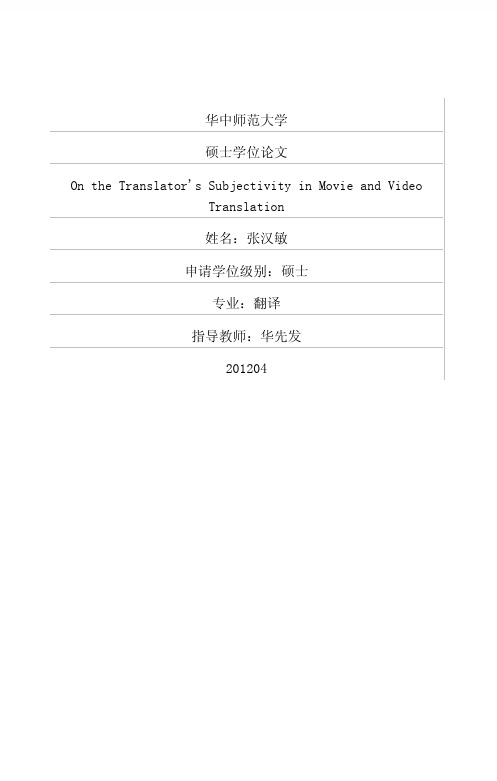
华中师范大学硕士学位论文On the Translator's Subjectivity in Movie and VideoTranslation姓名:***申请学位级别:硕士专业:翻译指导教师:***201204摘要译者是翻译的主体,在翻译过程中无论译者怎样追求客观也难逃自身的“主体性”经验。
译者的主体性包含三个方面:能动性,受动性和为我性。
哲学阐释学、权利话语和目的论分别为这三个方面提供了理论基础。
从哲学阐释学的角度说,主体经验是人类认知世界的必由之路。
人类的各种认知,包括对数理、科学和文学等等的理解都建立在由个体经验汇成的主体性经验之上。
这就为译者发挥主观能动性提供了基础。
从话语理论的角度来说,译者在翻译时要受到原文语言、读者要求和译者所处的历史文化背景的制约,这就是译者受动性的主要内容。
从目的论的角度说,译者的能动性和受动性是矛盾的两个方面,偏重任何一方都不妥。
平抑两者矛盾的标准就是译者的为我性。
影视翻译有其鲜明的特征,这是因为影视欣赏首先是一个读图的过程而非语言输入的过程。
镜头语言作为影视语言重要的组成部分以其直观性而成为了某种意义上的“世界语”,这就是人类认知具有共通性的例证,也是影视翻译中译者发挥主观能动性的先决条件和重要保障。
可译性是翻译中另一个重要的哲学问题:从哲学的角度来看,loo%的翻译,即绝对的翻译根本就不存在,所谓可译性就是无限接近绝对翻译即实现相对翻译的可能性。
在影视翻译中,有了图像作保障,合理发挥译者的主观能动性有可能使译文所表达的内容和承载的文化信息更贴近原文的内容和信息。
在影视翻译中,创造性叛逆是发挥主观能动性的重要表现形式,也是一种有效的翻译策略。
探讨影视翻译中译者的主体性也不能局限于分析其主观能动性,还必须考虑译者的受动性。
影视翻译究其实质仍是文本的翻译,因此译者必须尊重原文的话语权;与此同时,译者也要考虑观众的期待和要求;此外,译者同样还会受到其所处历史文化背景的影响。
论外宣翻译的译者主体性
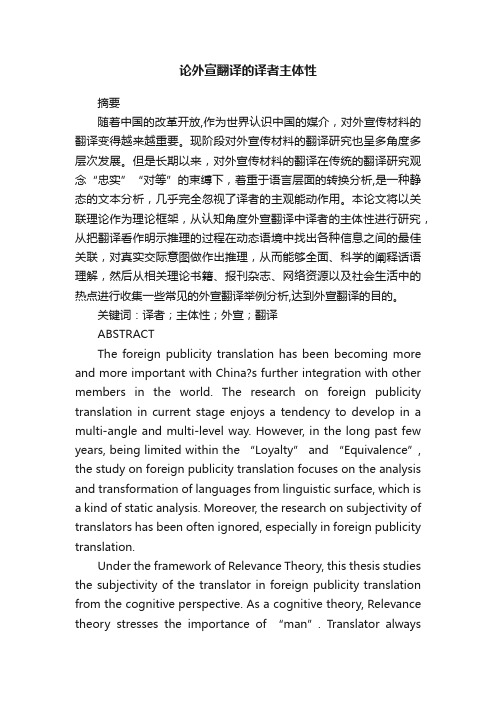
论外宣翻译的译者主体性摘要随着中国的改革开放,作为世界认识中国的媒介,对外宣传材料的翻译变得越来越重要。
现阶段对外宣传材料的翻译研究也呈多角度多层次发展。
但是长期以来,对外宣传材料的翻译在传统的翻译研究观念“忠实”“对等”的束缚下,着重于语言层面的转换分析,是一种静态的文本分析,几乎完全忽视了译者的主观能动作用。
本论文将以关联理论作为理论框架,从认知角度外宣翻译中译者的主体性进行研究,从把翻译看作明示推理的过程在动态语境中找出各种信息之间的最佳关联,对真实交际意图做作出推理,从而能够全面、科学的阐释话语理解,然后从相关理论书籍、报刊杂志、网络资源以及社会生活中的热点进行收集一些常见的外宣翻译举例分析,达到外宣翻译的目的。
关键词:译者;主体性;外宣;翻译ABSTRACTThe foreign publicity translation has been becoming more and more important with China?s further integration with other members in the world. The research on foreign publicity translation in current stage enjoys a tendency to develop in a multi-angle and multi-level way. However, in the long past few years, being limited within the “Loyalty” and “Equivalence”, the study on foreign publicity translation focuses on the analysis and transformation of languages from linguistic surface, which is a kind of static analysis. Moreover, the research on subjectivity of translators has been often ignored, especially in foreign publicity translation.Under the framework of Relevance Theory, this thesis studies the subjectivity of the translator in foreign publicity translation from the cognitive perspective. As a cognitive theory, Relevance theory stresses the importance of “man”. Translator alwaysplays an indispensable role in comprehending, interpreting, rendering the source text. The writer will collect various foreign publicity materials to find the Optimal Relevance among various information, infer and understand true communicative intention, in a overall and scientific way.Key words:translator; subjectivity; foreign publicity; translationContent1. Introduction (1)2. Foreign publicity translation (2)2.1 The definition of foreign publicity translation (2)2.2 The characteristics of foreign publicity translation (2)3. The translator’s subjectivity (4)3.1The definition of the subjectivity of the translator (4)3.2 The Significance of Translator?s Subjectivity (4)4. Relevance Theory (6)4.1 A general introduction of Relevance Theory (6)4.2 Principle of Relevance (6)4.2.1 Cognitive Principle of Relevance Cognitive (7)4.2.2 Communicative Principle of Relevance (7)4.2.3 Optimal Relevance (8)5. The subjectivity of the translator for foreign publicity translation under the framework of relevance theory (9)5.1 The subjectivity of the translator in the first ostensive-inferential Communication. (9)5.2 The subjectivity of the translator in the second ostensive-inferential communication .. 106. The problems and strategies in foreign publicity translation from the two ostensive-inferential communication processes (11)6.1 Inaccurate comprehension of the ST (11)6.2 Translator?s inc ompetence in rendering of the TT (12)6.3 Strategies (14)6.3.1 Reconstructing (14)6.3.1.1 The restructuring of titles (14)6.3.1.2 The restructuring of discourse patterns (15)6.3.2 Addition (17)6.3.2.1 The addition to cultural and historical background (18)6.3.2.2 The addition to political writing and economic phrases (19)6.3.3 Omission (20)7. Conclusion (22)Acknowledgements ............................................................................. 错误!未定义书签。
经典的英文诗歌(31)个
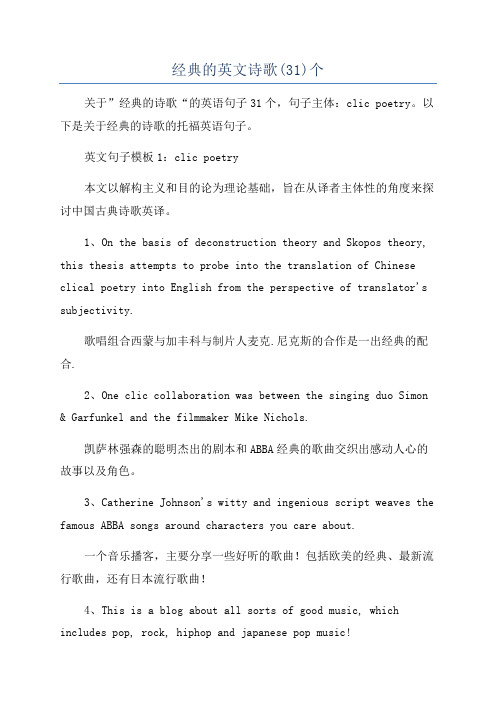
经典的英文诗歌(31)个关于”经典的诗歌“的英语句子31个,句子主体:clic poetry。
以下是关于经典的诗歌的托福英语句子。
英文句子模板1:clic poetry本文以解构主义和目的论为理论基础,旨在从译者主体性的角度来探讨中国古典诗歌英译。
1、On the basis of deconstruction theory and Skopos theory, this thesis attempts to probe into the translation of Chinese clical poetry into English from the perspective of translator's subjectivity.歌唱组合西蒙与加丰科与制片人麦克.尼克斯的合作是一出经典的配合.2、One clic collaboration was between the singing duo Simon & Garfunkel and the filmmaker Mike Nichols.凯萨林强森的聪明杰出的剧本和ABBA经典的歌曲交织出感动人心的故事以及角色。
3、Catherine Johnson's witty and ingenious script weaves the famous ABBA songs around characters you care about.一个音乐播客,主要分享一些好听的歌曲!包括欧美的经典、最新流行歌曲,还有日本流行歌曲!4、This is a blog about all sorts of good music, which includes pop, rock, hiphop and japanese pop music!他为经典电影《紫雨》所创作的歌曲也赢得了奥斯卡奖。
5、He won an Oscar for the original song score to the clic film "Purple Rain."6、I'm a lifelong fan of "Japlish, " English prosetranslated from the Japanese by someone whose sole qualification is owning a Japanese-to-English dictionary.经典的建筑让思想得以凝固,当歌曲和传说已经缄默,它依旧还在诉说。
a study on the translator's subjectivity
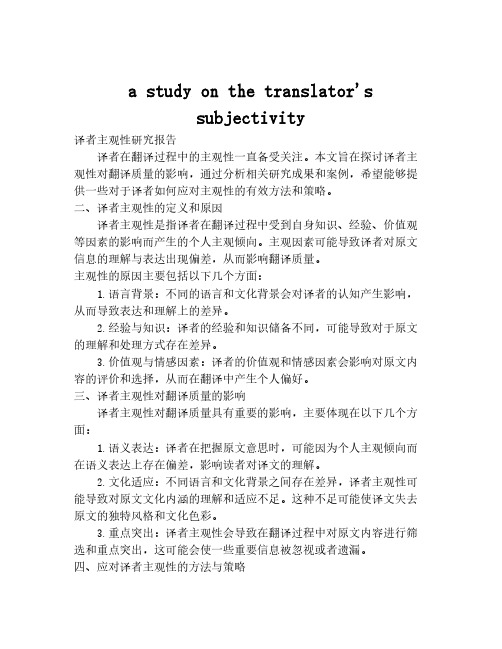
a study on the translator'ssubjectivity译者主观性研究报告译者在翻译过程中的主观性一直备受关注。
本文旨在探讨译者主观性对翻译质量的影响,通过分析相关研究成果和案例,希望能够提供一些对于译者如何应对主观性的有效方法和策略。
二、译者主观性的定义和原因译者主观性是指译者在翻译过程中受到自身知识、经验、价值观等因素的影响而产生的个人主观倾向。
主观因素可能导致译者对原文信息的理解与表达出现偏差,从而影响翻译质量。
主观性的原因主要包括以下几个方面:1.语言背景:不同的语言和文化背景会对译者的认知产生影响,从而导致表达和理解上的差异。
2.经验与知识:译者的经验和知识储备不同,可能导致对于原文的理解和处理方式存在差异。
3.价值观与情感因素:译者的价值观和情感因素会影响对原文内容的评价和选择,从而在翻译中产生个人偏好。
三、译者主观性对翻译质量的影响译者主观性对翻译质量具有重要的影响,主要体现在以下几个方面:1.语义表达:译者在把握原文意思时,可能因为个人主观倾向而在语义表达上存在偏差,影响读者对译文的理解。
2.文化适应:不同语言和文化背景之间存在差异,译者主观性可能导致对原文文化内涵的理解和适应不足。
这种不足可能使译文失去原文的独特风格和文化色彩。
3.重点突出:译者主观性会导致在翻译过程中对原文内容进行筛选和重点突出,这可能会使一些重要信息被忽视或者遗漏。
四、应对译者主观性的方法与策略为了提高翻译质量,译者应该采取一些有效的方法和策略来应对自身主观性的影响:1.注重语言和文化学习:译者应该不断学习和提升自己的语言能力和文化素养,加深对于源语言和目标语言的理解和适应,以减少主观因素对翻译的影响。
2.审慎处理翻译决策:译者在翻译过程中应审慎处理各种翻译决策,明确自己的偏好和目标读者的需求,以确保译文准确传达原文信息。
3.注意与作者沟通:在翻译过程中,与原文作者的沟通是十分重要的,可以更好地了解原文的意图和特点,减少因为主观因素产生的误差。
从《简·爱》译本谈译者的主体性
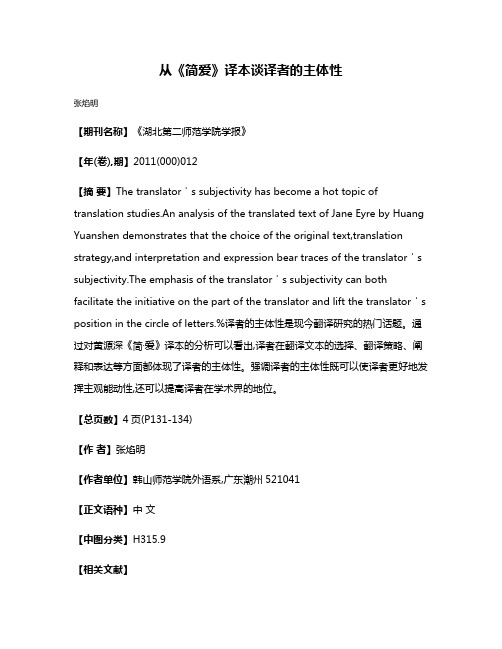
从《简爱》译本谈译者的主体性张焰明【期刊名称】《湖北第二师范学院学报》【年(卷),期】2011(000)012【摘要】The translator's subjectivity has become a hot topic of translation studies.An analysis of the translated text of Jane Eyre by Huang Yuanshen demonstrates that the choice of the original text,translation strategy,and interpretation and expression bear traces of the translator's subjectivity.The emphasis of the translator's subjectivity can both facilitate the initiative on the part of the translator and lift the translator's position in the circle of letters.%译者的主体性是现今翻译研究的热门话题。
通过对黄源深《简·爱》译本的分析可以看出,译者在翻译文本的选择、翻译策略、阐释和表达等方面都体现了译者的主体性。
强调译者的主体性既可以使译者更好地发挥主观能动性,还可以提高译者在学术界的地位。
【总页数】4页(P131-134)【作者】张焰明【作者单位】韩山师范学院外语系,广东潮州521041【正文语种】中文【中图分类】H315.9【相关文献】1.从接受美学视角看《简·爱》两种中译本译者的主体性 [J], 童敏君2.论译者的主体性在文学翻译过程中的体现——兼评《简·爱》的两个中译本 [J], 张艳萍;贾德江3.译者的主体意识和翻译风格--从译者主体性看《爱玛》的两个中译本 [J], 刘茵4.从女性主义角度看译者主体性的显现——以《简·爱》两个中译本为例 [J], 曾素芳;付香平;李丽华5.文学性与译者主体性在文学作品翻译中的体现——以《简·爱》三个译本为例 [J], 杨玉芳因版权原因,仅展示原文概要,查看原文内容请购买。
解构主义翻译观下的译者主体性研究
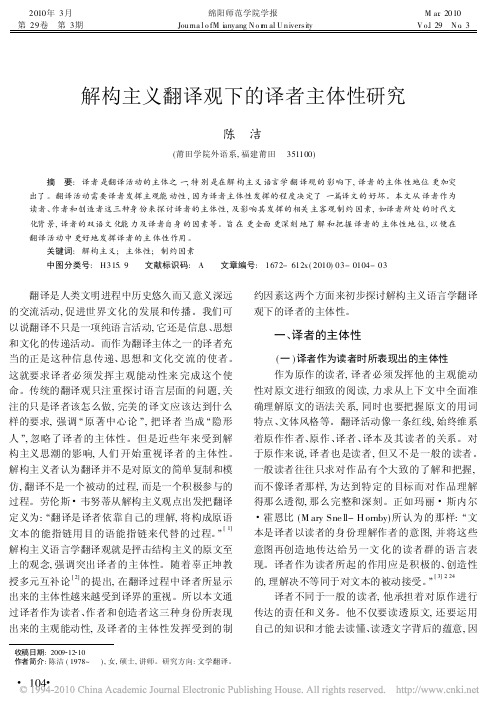
收稿日期:2009 12 10作者简介:陈洁(1978~ ),女,硕士,讲师。
研究方向:文学翻译。
2010年3月第29卷 第3期绵阳师范学院学报Journa l o fM i anyang N o r m al U niversity M ar .2010V o.l 29 N o .3解构主义翻译观下的译者主体性研究陈 洁(莆田学院外语系,福建莆田 351100)摘 要:译者是翻译活动的主体之一,特别是在解构主义语言学翻译观的影响下,译者的主体性地位更加突出了。
翻译活动需要译者发挥主观能动性,因为译者主体性发挥的程度决定了一篇译文的好坏。
本文从译者作为读者、作者和创造者这三种身份来探讨译者的主体性,及影响其发挥的相关主客观制约因素,如译者所处的时代文化背景,译者的双语文化能力及译者自身的因素等。
旨在更全面更深刻地了解和把握译者的主体性地位,以便在翻译活动中更好地发挥译者的主体性作用。
关键词:解构主义;主体性;制约因素中图分类号:H315 9 文献标识码:A 文章编号:1672-612x (2010)03-0104-03翻译是人类文明进程中历史悠久而又意义深远的交流活动,促进世界文化的发展和传播。
我们可以说翻译不只是一项纯语言活动,它还是信息、思想和文化的传递活动。
而作为翻译主体之一的译者充当的正是这种信息传递、思想和文化交流的使者。
这就要求译者必须发挥主观能动性来完成这个使命。
传统的翻译观只注重探讨语言层面的问题,关注的只是译者该怎么做,完美的译文应该达到什么样的要求,强调 原著中心论 ,把译者当成 隐形人 ,忽略了译者的主体性。
但是近些年来受到解构主义思潮的影响,人们开始重视译者的主体性。
解构主义者认为翻译并不是对原文的简单复制和模仿,翻译不是一个被动的过程,而是一个积极参与的过程。
劳伦斯!韦努蒂从解构主义观点出发把翻译定义为: 翻译是译者依靠自己的理解,将构成原语文本的能指链用目的语能指链来代替的过程。
文学翻译中译者主体性的体现--以《追风筝的人》两个中译本为例
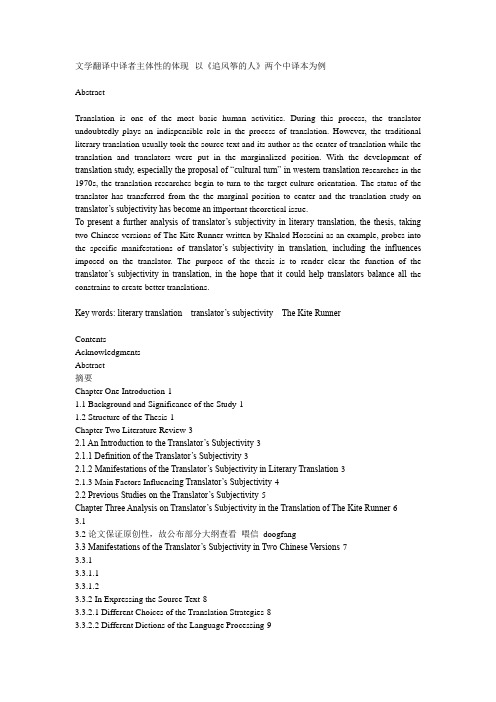
文学翻译中译者主体性的体现--以《追风筝的人》两个中译本为例AbstractTranslation is one of the most basic human activities. During this process, the translator undoubtedly plays an indispensible role in the process of translation. However, the traditional literary translation usually took the source text and its author as the center of translation while the translation and translators were put in the marginalized position. With the development of translation study, especially the proposal of “cultural turn” in western translation re searches in the 1970s, the translation researches begin to turn to the target-culture orientation. The status of the translator has transferred from the the marginal position to center and the translation study on translator’s subjectivity has become an im portant theoretical issue.To present a further analysis of translator’s subjectivity in literary translation, the thesis, taking two Chinese versions of The Kite Runner written by Khaled Hosseini as an example, probes into the specific manifestations of translator’s subjectivity in translation, including the influences imposed on the translator. The purpose of the thesis is to render clear the function of the translator’s subjectivity in translation, in the hope that it could help translators balance all the constrains to create better translations.Key words: literary translation translator’s subjectivity The Kite RunnerContentsAcknowledgmentsAbstract摘要Chapter One Introduction-11.1 Background and Significance of the Study-11.2 Structure of the Thesis-1Chapter Two Literature Review-32.1 An Introduction to the Translator’s Subjectivity-32.1.1 Definition of the Translator’s Subjectivity-32.1.2 Manifestations of the Translator’s Subjectivity in Literary Translation-32.1.3 Main Factors Influenc ing Translator’s Subjectivity-42.2 Previous Studies on the Translator’s Subjectivity-5Chapter Three Analysis on Translator’s Subjectivity in the Translation of The Kite Runner-63.13.2论文保证原创性,故公布部分大纲查看喂信doogfang3.3 Manifestations of the Translator’s Subjectivity in Two Chinese V ersions-73.3.13.3.1.13.3.1.23.3.2 In Expressing the Source Text-83.3.2.1 Different Choices of the Translation Strategies-83.3.2.2 Different Dictions of the Language Processing-9Chapter Four Conclusion-11 References-12。
翻译过程中的译者主体性探究
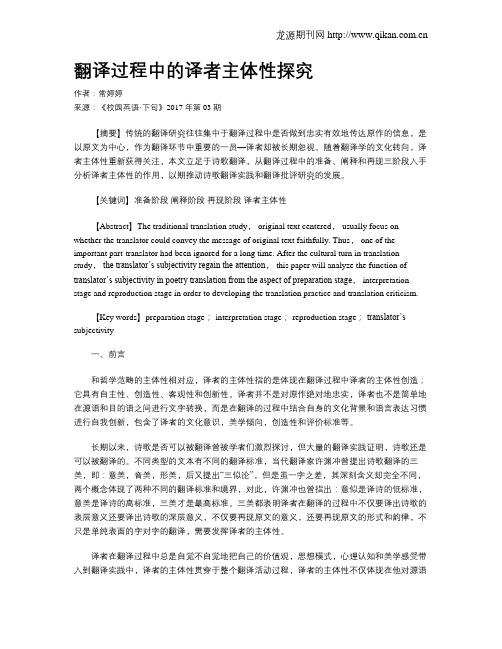
翻译过程中的译者主体性探究作者:常婷婷来源:《校园英语·下旬》2017年第03期【摘要】传统的翻译研究往往集中于翻译过程中是否做到忠实有效地传达原作的信息,是以原文为中心,作为翻译环节中重要的一员—译者却被长期忽视。
随着翻译学的文化转向,译者主体性重新获得关注,本文立足于诗歌翻译,从翻译过程中的准备、阐释和再现三阶段入手分析译者主体性的作用,以期推动诗歌翻译实践和翻译批评研究的发展。
【关键词】准备阶段阐释阶段再现阶段译者主体性【Abstract】The traditional translation study, original text centered, usually focus on whether the translator could convey the message of original text faithfully. Thus, one of the important part-translator had been ignored for a long time. After the cultural turn in translation study,the translator’s subjectivity regain the attention, this paper will analyze the function of translator’s subjectivity in poetry translation from the aspect of preparation stage, interpretation stage and reproduction stage in order to developing the translation practice and translation criticism.【Key words】preparation stage; interpretation stage; reproduction stage;translator’s subjectivity一、前言和哲学范畴的主体性相对应,译者的主体性指的是体现在翻译过程中译者的主体性创造;它具有自主性、创造性、客观性和创新性。
翻译美学视角下译者主体性研究——以《马丁·伊登》的两个中译本为例

河南师范大学硕士学位论文翻译美学视角下译者主体性研究--以《马丁·伊登》的两个中译本为例姓名:***申请学位级别:硕士专业:英语语言文学指导教师:***201105摘要翻译理论与美学的结合由来已久,随着中国翻译美学理论的发展,其理论概念、分类和阐述趋于清晰化、理性化,与中国美学思想的概括性、抽象性相比,具有明显的科学性和理论适用性。
中国翻译美学理论中对审美主体、审美客体的属性及其辩证关系的讨论为译者的主体性研究提供了一个新的视角。
本文主要以刘宓庆的翻译美学理论为框架,将其应用于对MartinEden(《马丁·伊登》)的两个中译本的对比与分析,将吴劳译本的口语化和孙法理译本的文学性作为考察对象,通过对比译本的用词和句子结构,揭示两种翻译特色背后隐藏的译者的审美情感和才情,分析在译者的主体性影响下,译本用词和句子结构产生的审美效果。
本文突破了以往单纯对比译本的模式,在分析对比译本的同时,以原文为参照,检验译者主体性发挥的合理性,论证译者的主体性对翻译审美效果的影响,印证了刘宓庆的翻译美学理论的合理性。
本文的对比分析旨在揭示译者的主体性对审美再现效果的影响,并对口语化和文学性两种表达方法的合理运用提出了建议,以期在审美角度对译者主体性的研究有所贡献。
笔者在运用刘宓庆的翻译美学理论探析译者主体性的同时,也对该理论进行了批判。
刘宓庆先生在《翻译美学导论》一书中对审美主体、审美客体及其辩证关系等问题的分类和阐述更明晰、合理,较早期的美学思想有很大的进步,但在讨论译者主体性与审美效果的关系方面,缺乏足够的方法论指导。
例如,在探讨译者的才情时,只是对译者的语言分析能力、表达法分析能力等做了阐述,并没有说明什么样的分析才是符合或接近审美标准的。
关键词:翻译美学,译者主体性,审美情感,口语化,文学性AbstractAtthebeginningoftheformationofChinesetranslationaesthetics,itsconceptsareabstract.However,withthedevelopmentofChinesetranslationaesthetics,theconcepts,classificationandinterpremtiontendtobeclearandrational.ComparedwiththeabstractnessofChineseaestheticthoughts,Chinesetranslationaestheticsisscientificandapplicable.Thediscussionofattributesofaestheticsubjectandaestheticobjectandthedialecticalmlmionshipbetweenthemprovidesthestudyoftranslator’SsubjectivitywithanewTakingLiuMiqing’Stheoryoftranslationaestheticsasaframework,especiallybyusinghistermsonaestheticsubject,thisstudyanalyzesthesubjectivefactorintheprocessoftranslationofMartinEdentodemonstratehowtranslatorsplaytheirsubjectiverolesandbreakthroughobjectiveconditioning.Intheprocessofanalysis,comparisonismainlymadebetweentwotranslatedversionsandtheoriginaltextisareferencetotestifywhetherthesubjectivityisreasonableornotandtoexploretheextenttowhichthedifferenttranslationisaffectedbythesubjectivityofthetranslator.Thestlldyattemptstorevealhowaestheticfeelingandcapabilityoftranslatorsbringinfluenceontheeffectsofaestheticrepresentation,andgivesomesuggestionsabouttheuseofcolloquialismandliterafiness.Thisdissertationattemptstocontributethegrowingstudyonsubjectivityofthetranslatorfromperspectiveoftranslationaesthetics.ThestudyalsoattemptstoassessLiuMiqing’Stheoryoftranslationaestheticsintermsofitslackofspecificguidanceoftranslationapproaches.Forexample,inthediscussionofcapabilityofthetranslator,Prof.Liujustinterpretsthecapabilityoflanguageandexpressionanalysis,hedoesnotgiveaclearcriterion011whatkindofanalysiscanbeconsideredasconformingtotranslationaesthetics.KEYWORDS:translationaesthetics,translator’Ssubjectivity,aestheticfeeling,colloquialism,litcrarinessAcknowledgementsIIIIIIIll11111IIIIII\1960595Theprocessofworkingonthisstudyhasbeenavaluableexperienceforme.MysinceregratitudegoesfirsttoProf.ZhaoWenjing,mysupervisor,forsheconstantlygavemeinstructionsandencouragement.Duringthecomposingofthedissertation,sheintroducedmesomerelevantreferencebooksandpatientlyofferedmeimportantadvice.Shegavemetheconfidencetodotheresearchontheissueoftranslationaesthetics.Withoutherinstructionsandencouragementthisdissertationcouldnotreachitspresentform.Furthermore,thespiritofherdevotiontoworkandthe8a18eofresponsibilityinspiredandwillinspiremetoworkhard.ManythanksgototheinstructorsattheSchoolofInternationalStudies.Manythanksalsogotomygroupmemberswhoactivelyorganizedandattendeddiscussioninthepastthreeyears.Throughthesesignificantacademicactivities,Igainedknowledgeandpleasure.IappreciateverymuchtoMcngXiaoli,myclassmate,whoenlightenedmeinthelogicalthinkingwhenIdesignedtheoutlineandstructureofthisdissertation.ManythanksalsogotoChenDongxia,whopatientlycorrectedtheerrorsinmydissertation,andtoTianLi,whosesmileandbehaviortoldmetheimportanceofconfidence--themostvaluablequalityforeachp吼'son.ChapterlIntroductionChapterIIntroductionThroughoutthehistoryoftranslationtheoriesofwestandChina,translationaestheticshasitson#nofphilosophy.ThedifferenceliesinthefocusOnthevirtueofbeautyinthewest(sceLiuMiqing2005:57)andthedebateofWen(文)andZhi(质)inancientChina.Withthedevelopmentoftranslationstudies,westerntranslationtheoriesturntobelinguisticorientedandseparatedfromaesthetics(8eeLiuMiqing2005:58).WhatisdifferentfromwesterntranslationaestheticsisthatChinesetranslationstudieshaverelatedtoChineseaesthetics;whatismore,“theallianceoftranslationandaestheticsisanimportantfeatureofChinesetranslationtheories.”(LiuMiqing2005:i)Forcenturies,theconceptsofancientChineseaestheticthoughtstendtobefuzzyandfocusontheformofexpressionandperception,thus,fromthetranslationoftheBuddhistScriptureson,translationaestheticshasthesamecharacteristicsundertheinfluenceoftraditionalaestheticthoughts.Thethoughtsandideasarealwaysabstractandscattered.WithrecentdevelopmentsinChinesetranslationaesthetics,inparticularthepublishedmonographsoffamoustranslatorsandtranslationscholarsinrecentyears,theelementsrelatedtotranslationaestheticsareclear.Inaddition,theresearchandcategoryhavealsobecomerational,specificandsystematic.Thebeautyoforiginaltexts(oraestheticvalueoforiginaltexts)andtargettexts,theroleoftranslatorsaretakenintoconsiderationinthosemonographs.However,fromtheperspectiveoftherelationofsubjectandobject,whichissimilartotheconceptsofphilosophy,theclassificationofconceptsandthearrangementofchaptersinLiuMiqing’SIntroductiontoTranslationAesthetics(2005)areclearer.Inthisbook.thenotionsofaestheticobject,aestheticsubject,therelationbetweenthemandthelevelsofaestheticsalesystematicallyinterpreted.Thisismoreconvenientforthestudyinthisdissertation.AccordingtoProf.Liu’Sillustration,translationaestheticsubject(TASforshort)mainlyreferstOtranslators,andtheattributesofTASaredividedintotwoaspects:objectiveconditioningandsubjectivedynamics.Inthisdissertation,thediscussionoftranslator’ssubjectivityputsemphasisonsubjectivedynamics.InProf.Liu’sbook,subjectivedynamicsincludesfouraspects,namelyaestheticfeeling,knowledge,capabilityandtenacity.Inthisdissertation,thediscussioncentersollaestheticfeelingandcapability.Inthebeginningoftranslation,translator’SaestheticfeelingunconsciouslydeterminesthetoneAStudyonTranslator’sSubjectivityfromthePerspectiveofTranslationAestheticsofthewholetranslatedversion,andtranslatorshavedifferentaestheticfeelings,thisdifferencedirectlycause3thedifferenceofwordingandothertranslationapproaches.SoisthecasewithdifferentfeaturesofWuLao’SandSunFali’Stranslation.Mr.Wh’ScolloquialismandMr.Sun’Sliterarinessreflectstheiraestheticfeelingsandcapabilities,inturn,theiraestheticfeelingsandcapabilitiesdeterminethedifferentfeatures---colloquialismandliterariness.Therefore,aestheticfeelingandfeaturesoftranslationareinacomplementaryrelation.Fromtheperspectiveoftranslationaesthetics,thegoretaskoftranslatorsistomakeaestheticaltranslatedversions,andtheprocessoftranslationinvolvesaestheticfeelingandtheformationofdifferentfeatures.ThisstudytakesLiuMiqing’StheoryoftranslationaestheticsasaframeworkandreconsidersoneofmasterpiecesbyJackLondon----MartinEdenbycomparingitstwoChinesetranslatedversions.SOastodemonstratehowtwofamoustranslatorsrepresentitsaestheticvalue.Thisdissertationexamineshow,intheprocessoftranslation,aestheticfeeling,idealandcapabilityoftranslatorsbringinfluenceontheeffectsofaestheticrepresentation,andhowtranslatorsbreakthroughtheobjectiveconditioningoforiginaltext.Onthebasisofthisanalysis,thisdissertationalsoprovidessomecriticalreflectionsontranslationaestheticsandsuggestionsabouttranslationcritics,whichshoulddoprofessionalcriticismonliterarytranslationandhelptoelevatereaders’levelofappreciation.Inwhatfollowsinthisintroduction,thereasonofselectingMartinEdenandtheissueoftranslators’subjectivityisgiven,andfinallythestructureofthisdissertationisintroduced1.1RationaleforFocusingonMartinEdenandtheTranslator’SSubjectivityMartinEden,JackLondon’Ssemi-autobiographicalnovel,isoneofJackLondon’SmasterpiecesinhisliterarycarP.A!l'.KnownfromYuJianhua’sbook《杰克伦敦研究》(TheStudyonJackLondon)(2009).thestudyofJackLondoninhisnativecountryhasexperiencedawindingcourse.Treated8.8spotlightordismissedfrommainstreamofcriticalattention,thecriticismofJackLondon’Sworksisalwaysrelatedtopoliticalfactor,“politicalutilitarianprevailsOVeraestheticmotives”(YuJianhua2009:359).TakingtranslationaestheticsandMartinEden8.8keywords,theauthorgoteightthesesaboutMartinEdeninCNKIdatabaseinthetimespanof1999-2011andallarewrittenfromtheperspectiveofliterature.Asanovelofindividualstruggling,itisofgreatsignificancetoyouthtoda弘ThissignificancealsoreflectsChapterlIntroductionthegreatnessofMartinEden.Oneofaestheticobject’Sattributesisthatitallowsthechangesofaestheticvaluewiththedevelopmentofsociety.Then,howistheaestheticvaluerepresentedintranslation?WhetherCallthetranslatorsaccomplishthisdayAndwhatfactorsaffecttheroleoftranslators?Thetheoryoftranslationaestheticsishighlyproductivefortheanalysisofsubjectivefactorssuchasaestheticfeelingandcapabilitywhichisreflectedintheprocessoftranslation.translatorsassubjectsAmongthesixarticleswrittenbyfamoustranslationscholars,abouttheissueofandsubjectivityofthetranslatorsfromtheperspectiveofphilosophyorinterpretation,onlyonearticlebyXuJunin2003claimsthatthecoreoftranslators’subjectivityisaestheticrequirementandaestheticcreativity.ExistingstudieshaveSOfarfailedtogiveanadequateaccountofthetranslator’Ssubjectivity.1.2StructureoftheDissertationThisdissertationattemptstodemonstratethathowtranslator’ssubjectivitybringsgreatinfluencesonaestheticeffects.andgivessomesuggestionontheuseof‘'colloquialism’’and“literariness’’(QinXiubai2002:53).Chapter2thendiscussestherelationbetweenaestheticsandtranslation,outliningitsoriginanddevelopments,andintroducessometranslationproperinLiuMiqing’SmonographIntroductiontoTranslationAesthetics.EdenandprovidessomecriticalcommentsonChapter3outlinesthemainaestheticvaluesofMartinthebasisofexamplesexcerptedfi'omthenovel.ThefourthChapterintroducestheattributesoftranslator’Ssubjectivity,subjectivedynamicsandobjectiveconditioning.Amongfouraspectsofsubjectivedynamics,thisdissertationselectstwoaspects,aestheticfeelingandcapability,whicharereflectedmuchmoreinthetranslationofMartinEden.Chapter5mainlydiscussesthedifferencesofthetwotranslatedversionsfromtheaestheticeffectstodemonstratehowtranslatorspromoteadvantagesandmakeupforshortcomings.demonstratestheapplicabilityoftranslationChapter6summarizesthefindingsofthestudy,notonlyaestheticstothepracticeofthetranslationofMartinEden,butalsoindicatesthefutureresponsibilityoftranslationcriticismandassessesLiuMiqing’Stheoryoftranslationaestheticsintermsofitslackofspecificguidanceoftranslationapproaches.Chapter2AestheticsinLiteraryTranslationChapter2AestheticsinLiteraryTranslationTracingbacktheoriginofaesthetics,wediscoverthataesthetics,infact,iscalledinthenameofphilosophyandaesthetics(LiuMiqing2005;ManRonggui2005;ShanJigang2007).Aspracticeoftranslationisgraduallydeepening,especiallywiththeextendingandtheunderstandingofaestheticsinChinesetranslationcircle.aestheticsisrelatedtOmanydisciplinesbesidesitsrelationship诵吐lliterarytranslation.Forinstance,tosomeextent,thetranslationofarticlesofscienceandtechniqueisalsorelatedtoaesthetics.Inthiskindoftranslation,thetransparencyCanbesP_圮nasanelementofaesthetics.Therefore,thereisstillaneedtoemphasizethatthefocusofthisdissertationistheaestheticsinliterarytranslation,notincludingothertypesoftranslation.A3toliterarytranslation,itisnecessarytointroducesimplyitscharacteristics80弱tonaturallydiscusstheissuesofaestheticsandevenhowtoachievethetranslationaestheticsintheprocessoftranslation.2.1TheCharacteristicsofLiteraryTranslationTheinductionofthecharacteristicsofonethingdependsontheunderstandingofitsdefinition;similarly,summarizingthecharacteristicsofliterarytranslationmakesnecessarythedefinitionofliterarytranslation.ThereisnoexplicitdefinitionofliterarytranslationinBaker’SRouaedgeEncyclopediaofTranslationStudies.AsBaker(2004:130)said,thedefinitionofliteratureandtranslationarenotsimpleorwelldefilledinmostcultures.Significantlyandusefully,thewordsofliterarytranslationfrompage130toandelaboratedexplanations,andrespectivelyknowwhattheliteratureisandpage133givereadersclearwhatthetranslationis.Literatureisalwayslinkedtoliterarytraditions,style,andgenreandSOon.Thetranslationhasnoborderlineswithadapmfionandrewriting.Indeed,inmostwesternsocieties,conceptoftheveryconceptoftranslationhasbeenreducedtoliterarytranslation(seeBaker2004:130·133).Since“literaturesaretiedtoparticularlanguages”(Baker2004:131),andbylearningfromM.GRose(2007:13),“literarytranslationisatransferofdistinctivefeaturesofaliteraryworkintoalanguageratherthanthatofthework’Sfirstcomposition”,itcanbesafelysaidthattheoriginaltextisthestartingpointofliteraryandaestheticelementsintheoriginaltextmustbetranslation,intheprocessofwhich,theinformation垒兰坐堂旦旦!堕璺!!坐21:!兰竺竖型!兰堡垒2竺£!竺£暨!兰竺!:!塑翌型!!12翌垒竺!!壁一一一一一..reflected.Thedistinctivefeaturesofaliterarywork,suchasrhetoric,genreandsoon,determinethecharacteristicsofliterarytranslation,mustbeconveyedinthetranslation..What,then,arethedistinctivefeaturesofaliterarywork?Novels,shortstories,plays,poems,etc.Canbecategorizedasliteraryworks.Literatureisakindofart;itistheauthor’scomprehensionabouttheoutsideworldatthattime.Theauthor’sfeelings,values,exp甜enceandknowledge,allofthemareencodedinliterarylanguage.However,onepointshouldbepaidmoreattention.Literarylanguagefeaturesvividandaestheticdictions,intentionalfigures,plottingand80on.Onsyntacticlevel,itisrichinvariedsentencepatterns,longandshort,alsosentencesandSOon,whichdependsoncontentincludingellipticalandtheauthor’Spreference.Infact,thesecharacteristicsmainlyserveitsfunction.Itaimstoexpressone’Semotionbyfocusingonthedescriptionofimage,feelings,spiritandthinking,andtherelationshipbetweenmealandnature.Thesearethecontentofaliterarywork,andthelanguageistheform.Therefore,theformandthecontentshouldbebothrepresentedintranslatedversion,evilthoughrepresentationcannotbeachievedabsolutely.Theformandthecontent(orcanbecalledmaininformation)arethebasisorthereferencefortranslation,thispointisthescientificcharacteristicsofliterarytranslationbesidesitsartisticfeature.Astoliterarytranslation,manyscholars,asfarasIreadintheirbooks,inevitablyresearchtheissueofreproduction,recreationorrepresentation(differentscholarsusedifferentterms)inliterarytranslation.ThereisonepointtoSeethattheartandliterature,theartandliterarytranslation,therelationshipbetweenaestheticsandliteratureisclose,SOisthecasewithaestheticsandliterm'ytranslation.Alloftheserelationshipsmakethefollowingintroductionofaestheticsnecessary.2.2TheStudyofTranslationAestheticsintheWestManyofphilosophers,artistsandtranslatorsofancientRomeandGreekdiscussedorfocusedonaesthetics,exactlytosay,theydiscussedtheaestheticalpropositionfromperspectivesofartsandphilosophy.Theirideasaresoheterogeneousthatitisdifficulttogetunifiedoverviewofeitherthehistoryorcurrentthinkingabouttranslationaesthetics.Inotherwords,therearenoclearandsystematictheoriesoftranslationaestheticsbutgeneralempiricalwordswhichareconcludedfromtheirtranslationpractice.Eventhoughtheconclusionsarealwayssubjective,thesewordsarestillpreciousandusefulforthediscussiononword-for-wordorsense.for-sensetranslation.MarcusTulliusCicero(106-43BC)opposedtheabovecategoryofdisagreeingword-forwordtranslationbutadvocatingsense-for-sensetranslation.QuintusHaecusHorace(65-8BC),whofollowedCicero,alsodisagre:eclwiththeslavishtranslator.A.ETytler(1747-1814)proposedhisfamous“theThreePrinciples”inhisEssayonthePrinciplesofTranslation.“theThreePrinciples”isdeeplyrootedinclassicartisticaesthetics.MartinLuther,themostinfluentialtranslatorofBiblein16mcentury,emphasizedtheaestheticvalueoftranslatedversions.GeorgeChapman(1559—1634),EnglishfamoustranslatorofHomertranslatedversionsjustlikethetransmigrationofthoughtthattranslatorsmustmakethespiritandtoneoftheoriginalwork.Thefollowingscholars,JohnDryden,AlexanderPope,Goethe,andMaaewArnoldandSOon,alsogavethegeneralideasthattranslationisakindofart,allaestheticreproductionoftheoriginalworks.Anywesternscholarsoftranslationaestheticsgavetheideaarmed、)vithcharacteristicsofspeculativebetweenphilosophyandaesthetics.妒ThereisnoexplanationoftheitemoftranslationaestheticsoraestheticsinBaker’sRoutledgeEncyclopediaofTranslationStudies(2004).ItisthemanifestationoftheconceptoftranslationaestheticsCanbehavingnofixedandexactdefinition.Hencetheabovediscussionoftranslationaestheticsinthewests嘲asahistoricalreviewofimportantthoughtsontranslationaesthetics.ThediscussionaboveisconductedtOlisttherepresentativesandtheirideasoftranslationaestheticstodistinguishthefeaturesofChinesetranslationaesthetictheorieswhichwillbeintroducedasfollow.2.3TheStudyofTranslationAestheticsinChinaTosomeextent,translationaestheticsthoughtinChinaaregenerallycloselyrelatedto,orcanbesafclysaid,comefromtheoryofaesthetics.Itoriginatesfromthepropositionofphilosophicalaesthetics.KnownfrommonographsofChineserenownedtranslationresearchers,infact,translationaestheticsCanbedividedintotwoparts,translationaestheticthoughtsandtranslationaesthetictheories.Thesetwodifferentpartswillbeexplainedasfollow.Amongcontemporarytranslationaestheticthoughtsillustratedbydifferentwell-knowntranslatorsandscholars,thisdissertationmainlyappliesLiuMiqing’Stheory,therefore.Prof.Liu’sthoughtswillbeintroducedinaseparatesection,inwhichsomemonographsarcbrieflymentioned80astoexplainthereasonwhytheauthorselectsProf.Liu’Stheory.AStudymnslator’sSubjectivityfromthePerspectiveofmnslationAesthetics2.3.1PreviousTranslationAestheticThoughtsHere,so-called“previous”referstotheperiod--ancientChina.InancientChina,LaoZi,Confucius,Mencius,andothergreatmen,proposedtheideaofaesthetics,whichmainlyreferstotherelationshipofcontentandform(文与质),withitsnatureofabstractionandsubjectiveunderstandingofmenanduniverse.FromtherenditionofBuddhismlections0n,thedisputeofcontentandfo—rmisgraduallyprecededintheissueoftranslation.Therefore,thepropositionofcontentandforminartisreflectedintranslation.UntilQingdynasty,theattributionofcontentandformbecomescomparativelyclear;theunification.ofcontentandformisacceptedin谢despheres.Therelationshipofcontentandformisthebasicissueintranslation,inaddition,theunificationofcontentandformreflectstheaestheticrulesorhabit,SOthediscussionandthefinalunificationhavegreatinfluencesonancienttranslationcauseseVenOilcontemporarytranslationalactivities.Hence,greatattentionshouldbepaidtotheunificationofcontentandform.Peopleneedtoenjoythebeautyofform,buttherealityandreliabilityofcontentcannotbeignored.ThereasontodifferentiatetheconceptoftranslationaestheticthoughtandtranslationaesthetictheoriesmainlyliesinclearlyunderstandingthedevelopmentandachievementsofChinesetranslationaesthetics.What’Smore,inthisprocesscanresponsibilityoftranslatorsbeclear,inotherwords,fromtheperspectiveofaesthetics,translatorsshouldbalancetherelationshipofbeautyandtruth.Eventhoughtheissueofaestheticsintranslationhasbeencaredaboutinprevioustranslationthoughts,theproblemoffreedomandlimitsoftranslatorsarenotdiscussedindetail,whichmakecontemporary2.3.2LiuMiqing’STranslationAestheticTheoryForthisdissertation,ProfessorLiu’stermsandclassificationareclearerandmoresystematic.Inhismonograph,ProfessorLiusystematicallyintroducestheimportantissuesabouttranslationaestheticsfromitsorigintoitscomponentsliketranslationobjecttranslationsubjectsandtherelationshipsbetweenwesternandChinesetranslationtheories.BesidesthedebateofcontentandforminancientChinesetranslationcircle,inthefollowingexplorationoftranslationaesthetics,thereappearSOmanyfamousscholarsandassertions.ThroughoutProf.Liu’Sbook,thediscussionissystematicandthedivisionofinLiteraryTranslationChapter2Aestheticsthewhole,hedescribestherelationshipbetweentheoriginalworksandconceptsisclear,thatis,ontranslatedversionsfromtheperspectiveofaestheticobjectandaestheticsubject,whichareapairofdialecticalconcepts.ThiskindofdivisionCallwellservetheresearchofthisdissertation.Inthisdissertation,theauthortreatsaestheticfeelingandcapabilitymainaspectsoftranslators’subjectivity,anddiscusseshowtranslatorscouldplayitssubjectiverolesintheprocessoftranslation.Asaeulogizedfounderofmoderntranslationtheory,YahFuisveryfamiliartOreaders.Histhree-characterprinciplefaithfulness,expressivenessandelegance(信,达,雅)aredeductedbylatetranslationresearchersasfaithfulness,expressiveness,exactness(信,达,切)orfaithfulness,expressiveness,optimum(信,达,优)andSOon.Theseideasarecloselywithaestheticeffectsoftranslation,SOtheycouldbeconsideredasagoodreferenceaccordingtospecificrequirementofdiscussion.Otherprominentmastersoftranslationtheoriesandtheirideas,suchasFuLci’Slikenessofspim,QianZhongshu’Stransmigration,arealsonotunfamiliar.However,asthedevelopmentoftranslationtheories,moresystematicandnewertheoriesareneededtoexplore.Asfar嬲thisdissertationiswritten.therearethreenewmonographs:LiuMiqing’S_IntroductiontOTranslationAesthetics(2005),MaoRonggui’STranslationAesthetics(2005),WangPing’SLiteraryTranslationAesthetics(2009).Amongthem,Mr.MaobetweenChineseandEnglish;Mr.RongguidiscussestranslationaestheticsbycomparingthedifferenceWangPinggivesanoverviewofmainideasoftranslatorsandscholarsbutnocleardefinitionofattributesofthetranslators.Prof.Wang’Sbookisthelatest.itsadvantageliesinrichanddetaileddescriptionandexamples,especiallyitsdeepandspecialanalysesabouttranslatorsinrespectivefivechaptersfromdifferentaspects.However,thedescriptionandquotationsare80manyanddetailedthattherea∞noclearideasofhisownandterms.Takinganillustrationinhisbookasanexample,theoriginalsentenceisasfollows.译者充分发挥审美心理机制,把握作家孕育审美意象时的艺术构思和情感体验,将其化为自己的审美体验,并思考如何把这种审美再体验通过恰当的译语文字形式传达出来.(王平2009:129)Theideaofthissentencecanbebrieflysummarized勰alinearrelationbyLiuMiqing’Sterms:aestheticfeeling--aestheticideal--aestheticrepresentation.Forthisdissertation,thecleardivisionandtermsarenecessary.Therefore,thisdissertationmainlyextendsthediscussionaccordingtoProf.Liu’Sillustrations.垒!!竺!Z竺里!垫翌塑!:!墨竺堕竺!∑!堡墅竺尘坚£!!垡!:!堕!堑竺旦垒竺!!壁堡!2.3.2.1TheMainNotionsinLiuMiqing’STranslationAestheticTheoryFromancienttimes,theemphasisofcounterpartrelationbetweenmaterialandhuman,oruniverseandhumanhasbeenatopicofdiscussion.ItisalsoasymbolofabstractthinkinginChina.Intranslationaestheticstudies,thereisapairofconcepmnamedtranslationaestheticobject(TAOforshoa)andtranslationaestheticsubject(TASforshort).(1)TranslationAesthetic0bjectAccordingtoLiuMiqing(2005:86-121),TAOreferstothesourcelanguage(SLforshort)withaestheticvaluewhichdeservesaestheticattentionoftranslationaestheticsubject(TAS)whogenerallyreferstotranslators.ThegeneralattributeofTAOliesinitsaestheticvaluewhichCallarouse“delight'’(ibid:87)toTAS.Besidesitsgeneralattribute,TAOalsohasanotherfiveattributeswhichwillbelistedasfollows.First,theaestheticvalueofTAOattachestoaestheticformofSLtext.Takethetranslationofpoemforexample,ifthepoemisnotrhymed,thereshouldnotberhymedinitsrendition;otherwise,thebeautyisnottrue.Second,TAOshouldbeequivalenttoaestheticeffectsofSL.Thispointreferstotheproblemofbroadeningandnarrowingofwords’meaning.ThUd,TAOadmitstheperceptiveflexibilityofTAS.DuetodifferentetymologyofChineseandEnglish,whenfacingtheproblemofnotbeingabletofmdtheequivalentwordorsentence,TAScallactivelydealwithit.Fourth,TAOallowsthechangesofaestheticvalueofSLcausedbyhistoricaldevelopment.Asthesocietydeveloping,people’stasteandlevelofappreciationisinevitablychanging.aliteraryworkshouldbeeternalbutitstranslatedversioncanchangeinacceptableaestheticscope.FifHl.therearedifferentaestheticlevels.Thisreferstothedifferencebetweenartisticworkandnon-artisticwork.However,theliteraryworkisnotinthisthispointisnotcase,80discussedinthisdissertation.(2)TranslationAestheticSubjeetLiuMiqingfirstgivesthedefinitionofaestheticsubject,whichreferstothel把=1-¥onwhoembarksonaestheticactivityonaestheticobject;likewise,theaestheticsubjectoftranslationisthetranslator.Infact,asfortranslators,theysometimesCanbeconsidered够readers.TheiridentifiesasreaderscallhelpUSunderstandotherconceptssuchasaestheticfeeling,aestheticidealandSOon.Aestheticfeeling,accordingtoProf.Liu,includestwoaspects:oneistheperceptionofwriters’whentheywerewriting,whiletheotheristheemotionalfeedbackoftranslators.Therefore,aestheticfeelinghasthecharacteristicsofindirectness.Thatis,everlforwritersthemselves,thefeelingcanchangewiththevarietiesofsituation.Soitisadifficultyfortranslatorstoapproachthetruefeelingwhichwasexpressedbywriters.Translatorsneedtoaccomplishthetaskoftranslationbytheirimagination.Forreadersandresearchersontranslationstudies,can锨1∞translators’aestheticidealformtranslatedworks.Astoaestheticideal,LiuMiqing(2005:they311)definesthataestheticidealistheunityoftranslators’rationalandperceptualrecognitionofthebeconsideredastheprincipleoftranslatorstreatingrepresentingthebeautyoforiginalworksoritcantranslationasanartisticpractice.Aestheticidealiscloselyrelatedtotranslationaestheticrepresentation.EventhoughProf.Liustressestheimportanceofaestheticfeelingandaestheticideal,thedemonstrationofaestheticidealisnotspecificandsufficient.ItisnotcloselyconnectedwiththeanalysisLiuMiqing(2005:168)statesthattranslatorshavethedualtasksintheprocessoftranslation,thatis,thecognitionandappreciationofthebeautyinSL,therepresentationofthebeautyintargetlanguage(TLforshort).TorecognizeandappreciatethebeautyinSL,itrequiresthehi【ghqualityoftranslators,whomustknowwherethebeautyofSLis,andthenmakeaccuratejudgmentstopreparewellforthenextstep:(3)AestheticRepresentationForLiuMiqing(2005:311),‘'thebeginningofaestheticrepresentationistheendofaestheticcontemplation'’,aestheticcontemplationreferstothewholeprocessoftranslationbeingdividedintothreesteps:perception,imaginationandcomprehension.Theeffectsofaestheticrepresentationarenaturallyembodiedinthetranslationproducts,whichcanloadedwithalleffortsoftranslators.notbesimplylabeledasgoodorbad.ThetranslatedliteraryworkisEachtranslationinevitablyembodiesindividualaestheticfeeling,whichmakestranslatedversionsbecomeremarkedthategoistrepresentation“egoistrepresentation”(LiuMiqing2005:182)oftranslators.Itistobcnotonlyreflectsthetranslator’Saestheticfeeling,butalsoconformstotheaestheticfeelingofthewriter.Whatismore,thelatteristhefirstcondition.Aconclusioncarlbedrawnthattheroleoftranslatorsplaysinthewholeprocessoftranslation,includingthefmalstepoftranslatioa---aestheticrepresentation,whichalsoreflectstheaestheticfeeling,andSOon.Fromtheresultsoftranslation,thesubjectivityoftranslatorscanbedeductedcapability垒!坐塑!璺!堕里竺:!兰!竖型!兰壁墅竺!!!旦竺!里!鲤∑121:!翌璺!!坐!竺翌垒竺!!壁!!苎2.3.2.2AssessingLiuMiqing’STranslationAestheticTheoryThetheorizingoftheabovethreeconceptsoffersUSagoodmodelforstudyingthemainfactorsinvolvedintheprocessoftranslation.ItopensupawiderareaofresearchforscholarsoftranslationstudiesandprovidesamoreclearandsystematicdiscussionfortheconstructionofChinesetranslationtheory,becausethedemonstrationinProf.Liu’sbookiscomparativelyscientificthanthepreviousexperiencedaestheticthoughts.Itfurtherexploresthebasiclevelandcomprehensivelevelof“artisticcreationoftranslation'’(B.Croce1902,citedinLiuMiqing2005:240).Inthediscussionofdifferentlevelsoftranslationaesthetics,therelevantissueslikeaestheticfeeling,aestheticidealandaestheticrepresentation,areallillustrated.Theillustrationoftheseconceptsisnotonlyofgreatbenefitfortheunderstandingoftranslators’subjectivity,butalsogivesreadersandresearchersasignificantenlightenment.However,LiuMiqing’Streatmentofthoseconceptsisnotwithoutitsweaknesses.Firstofall,mostoftheexamplesgiveninhisbookarethetranslationofpoems.Astothepoem,nomatterwhatisChineseorEnglishpoem,image,symbolandrhythmarethecentraltopic.Sothereisaquestion:ifthereisnospecialimageandsymbolinanovelortheimageisnotitsmainaestheticvalue,then,howcanwefindandjudgethebeautyoftranslation?Whatistheaestheticcriterionaboutthetranslationofnovels?EventhoughProf.Liupointsoutthatthecomprehensiveleveloftranslationaestheticsmainlyreferstoliterarytranslation,theexamplesseemasifliterarytranslationisthetranslationofthepoem.Second,therelationshipbetweenaestheticidealandaestheticrepresentationisnotsufficientlyelaborated.Aestheticprinciplesinaestheticidealare“generalandspecific,covertandovert,amplifyingandcontracting'’(LiuMiqing2005:336.341).Forinstance,thetranslationofanAmericanproverb‘'AllworkandnoplaymakesJackadullboy'’,translating“Jack'’into“孩子”istheapproachofgeneralizing.Theexamplesofcovertanoverttranslationisthetranslationofmovienames,itisnotcloselyrelevanttothestudyinthisdissertation.Eventhoughitsweakness,thereisnodenyingthattheillustrationofamplifyingandcontractingishelpfulforthestudy.However,inthefollowingtext,thereareonlyafewwordsabouttheaestheticcriterionofnoveltranslation,thatis,fluentandtransparent.Therefore,attheendofthisdissertation,theauthormentionstheweakness.Thereisnosufficientelaborationandguidancefornoveltranslation.Despiteitsshortcomings,Prof.Liu’Stheoryoftranslationaestheticssuccessfullymakesadivisionoftranslationaestheticsubjectandobjectandillustratestheirrelationshipandartisticcreativelevels.Itallows。
译者主体性研究
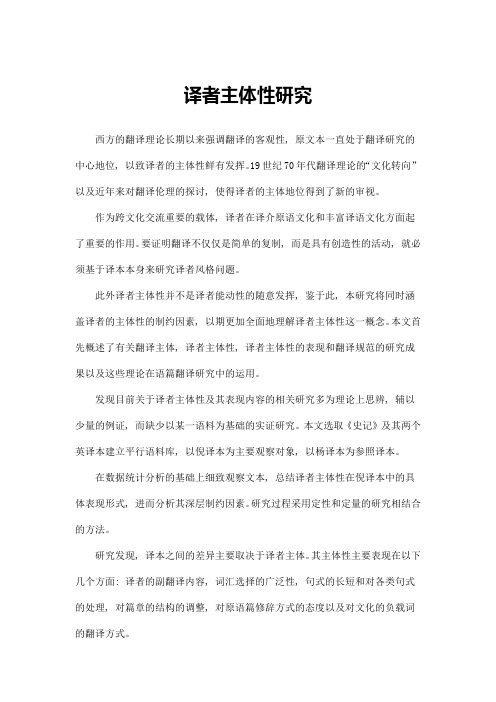
译者主体性研究西方的翻译理论长期以来强调翻译的客观性, 原文本一直处于翻译研究的中心地位, 以致译者的主体性鲜有发挥。
19世纪70年代翻译理论的“文化转向”以及近年来对翻译伦理的探讨, 使得译者的主体地位得到了新的审视。
作为跨文化交流重要的载体, 译者在译介原语文化和丰富译语文化方面起了重要的作用。
要证明翻译不仅仅是简单的复制, 而是具有创造性的活动, 就必须基于译本本身来研究译者风格问题。
此外译者主体性并不是译者能动性的随意发挥, 鉴于此, 本研究将同时涵盖译者的主体性的制约因素, 以期更加全面地理解译者主体性这一概念。
本文首先概述了有关翻译主体, 译者主体性, 译者主体性的表现和翻译规范的研究成果以及这些理论在语篇翻译研究中的运用。
发现目前关于译者主体性及其表现内容的相关研究多为理论上思辨, 辅以少量的例证, 而缺少以某一语料为基础的实证研究。
本文选取《史记》及其两个英译本建立平行语料库, 以倪译本为主要观察对象, 以杨译本为参照译本。
在数据统计分析的基础上细致观察文本, 总结译者主体性在倪译本中的具体表现形式, 进而分析其深层制约因素。
研究过程采用定性和定量的研究相结合的方法。
研究发现, 译本之间的差异主要取决于译者主体。
其主体性主要表现在以下几个方面: 译者的副翻译内容, 词汇选择的广泛性, 句式的长短和对各类句式的处理, 对篇章的结构的调整, 对原语篇修辞方式的态度以及对文化的负载词的翻译方式。
从统计数据和研究结果来看, 1.倪译本更为复杂, 副翻译内容和注释丰富;2.倪译本词汇选择更广, 两个译本形符比分别为11.58和10.4;3.较之于杨译本, 倪译本句式简短, 平均句长分别为15.14和17.2, 句式处理灵活;4.在段落、篇章处理, 倪译本与原文有较大差异, 段落数分别为587和130;5.译本在保留原文修辞方面做了积极的努力;文化负载词的翻译策略基本为直译加注, 注释不独立于译文, 而与其形成整体。
认知语言学视角下译者主体性在文学形象塑造中的体现--以《罗刹海市》英译文学形象为例

认知语言学视角下译者主体性在文学形象塑造中的体现--以《罗刹海市》英译文学形象为例袁晓亮【摘要】自从翻译“文化转向”以来,译者主体性研究得到了越来越多的关注。
认知语言学的翻译观从体验和认知的视角阐释了译者主体性。
以《聊斋志异》中《罗刹海市》的两个英译本为例,探讨认知语言学视角下译者主体性在文学形象塑造中的体现。
%Since the cultural diversion of translation , studies on translators ’ subjectivity have received more at-tention than ever .A cognitive linguistic viewpoint on translation explains it from the perspective of bodily experi-ence and cognition .This paper tries to analyze the translators ’ subjectivity in the two English versions of The Rakshas and the Sea Market, and illustrates the translators ’ subjectivity in literary image construction from the perspective of cognitive linguistics .【期刊名称】《兰州工业学院学报》【年(卷),期】2014(000)003【总页数】4页(P87-90)【关键词】认知语言学的翻译观;译者主体性;文学形象【作者】袁晓亮【作者单位】辽宁师范大学外国语学院,辽宁大连 116029【正文语种】中文【中图分类】H315.9翻译是一项原文本、原作者、译者、译本、读者等多个主体交互作用的活动。
在女性的名义下“重写女性主义翻译理论对译者主体性研究的意义

在女性的名义下“重写女性主义翻译理论对译者主体性研究的意义一、本文概述在全球化日益深入的今天,翻译作为一种跨语言、跨文化的交流活动,其重要性日益凸显。
然而,传统的翻译理论往往忽视了译者在翻译过程中的主体性,这在一定程度上限制了翻译研究的深度和广度。
特别是在女性主义翻译理论的视角下,译者的主体性更是被赋予了特殊的意义。
本文旨在探讨女性主义翻译理论对译者主体性研究的意义,从而揭示译者在翻译过程中的重要作用,并推动翻译研究的进一步发展。
本文首先将对女性主义翻译理论进行简要介绍,阐述其核心观点和理论基础。
随后,将深入探讨译者主体性的内涵及其在女性主义翻译理论中的体现。
在此基础上,本文将分析女性主义翻译理论对译者主体性研究的启示和影响,包括如何提升译者的地位、如何促进译者的自我认同以及如何发挥译者在翻译过程中的创造性等方面。
本文将总结女性主义翻译理论对译者主体性研究的贡献,并展望未来的研究方向。
通过本文的论述,我们期望能够深化对译者主体性的认识,推动翻译研究的多元化发展,并为女性主义翻译理论的研究提供新的视角和思路。
我们也期望通过这一研究,能够激发更多学者对译者主体性问题的关注和研究,共同推动翻译学科的繁荣和发展。
二、女性主义翻译理论的核心观点女性主义翻译理论的核心观点在于重新审视和改写传统翻译理论中的权力关系,强调译者在翻译过程中的主体性和创造性,以及在翻译实践中实现性别平等的重要性。
该理论认为,翻译不仅仅是语言的转换,更是一种文化的传递和权力的重构。
在传统的翻译理论中,译者常常被视为隐形的、被动的角色,而女性主义翻译理论则挑战了这种观念,认为译者应该成为翻译过程中的主体,发挥自己的创造性和主观能动性,对原文进行重写和再创造。
女性主义翻译理论的核心观点之一是“重写”(Rewriting)。
这一概念指的是译者在翻译过程中,不仅要考虑到语言的转换,还要考虑到文化、社会、历史等因素的影响,对原文进行重写和再创造。
译者主体性
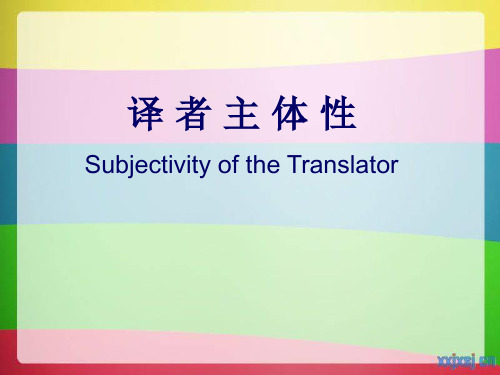
直至20世纪 年代 直至 世纪70年代 西方翻译研究走出了纯语 世纪 年代,西方翻译研究走出了纯语 言研究的重围,开始文化转向 言研究的重围 开始文化转向(cultural turn),使译 开始文化转向 使译 者的文化身份和主体地位得以彰显,译者真正从幕 者的文化身份和主体地位得以彰显 译者真正从幕 后走向前台。 后走向前台。随着译界对翻译活动中文化因素的 重视,译者的作用和地位受到越来越多的关注 译者 重视 译者的作用和地位受到越来越多的关注,译者 译者的作用和地位受到越来越多的关注 主体性也逐渐成为学者们的研究对象,“译学研究 主体性也逐渐成为学者们的研究对象 译学研究 悄悄经历了‘语言 文化———人’的转变 悄悄经历了‘语言———文化 文化 人 的转变, 完成了一次由本体到主体的跨越。 完成了一次由本体到主体的跨越。
例3 将道人肩上褡裢抢过来背着…… He transferred the sack from the taoist’s shoulder to his own,……(Yang 17) But Shi-yin merely snatched the satchel that hung from the other’s shoulder and slung it from own,……(Hawkes 65) 像中国古代物品“褡裢”,在中国现代文化中也 已消失。杨译为sack,使其通俗化;“褡裢”在英美文 化中根本就没有,Hawkes便译为“小背 包”(satchel)。在翻译中两者都有所失。这种远古 文化造成的(文化和词汇)空缺无法弥补。译者被迫 发挥自己的主观能动性。
例4 代表团由各行各业的人组成。 1.People from numerous fields form the delegation. 2.The delegation is composed of people from the spectrum of professions. 3. People from a variety of professions group together to be this delegation. ” 分别是由一名医生,物理学家和文学家对这句话的 翻译,体现了不同行业独自特征,鲜明个性。
诗歌词语翻译中译者主体性的认知识解--以杜甫《春望》8译本为例

诗歌词语翻译中译者主体性的认知识解--以杜甫《春望》8译本为例杨露;梁燕华【摘要】With the emergence of the cultural turn in translation studies and the trend of Chinese culture ’ s going abroad , increasing attention has been paid to translator ’ s subjectivity in poetry transla-tion . This paper conducts an analysis of 8 English translations of Spring View via four dimensions of cognitive construal—scope and background , perspective , salience and specificity , aiming to provide a reasonable cognitive interpretation on translator's subjectivity in poetry translation and thus facilitate translators' devotion to spreading traditional Chinese culture abroad .%随着翻译研究“文化”转向及“中国文化走出去”浪潮兴起,诗歌英译中译者主体性研究逐渐受到重视。
从认知语言学认知识解角度对杜甫《春望》8译本差异进行对比,通过辖域与背景、视角、凸显、详略度等维度对译本所呈现出的多样性进行考察,为诗歌翻译译者主体性提供合理认知解读,并为译者推动中国传统文化“走出去”提供一定借鉴。
【期刊名称】《乐山师范学院学报》【年(卷),期】2016(031)009【总页数】5页(P56-60)【关键词】诗歌翻译;《春望》;译者主体性;认知识解【作者】杨露;梁燕华【作者单位】广西大学外国语学院,广西南宁 530004;广西大学外国语学院,广西南宁 530004【正文语种】中文【中图分类】H059杜甫诗作,留存于世有1400余首,其不少诗作被不断重译在世界范围传播,其中备受瞩目的当属杜诗英译。
从评价理论的角度分析译者的主体性
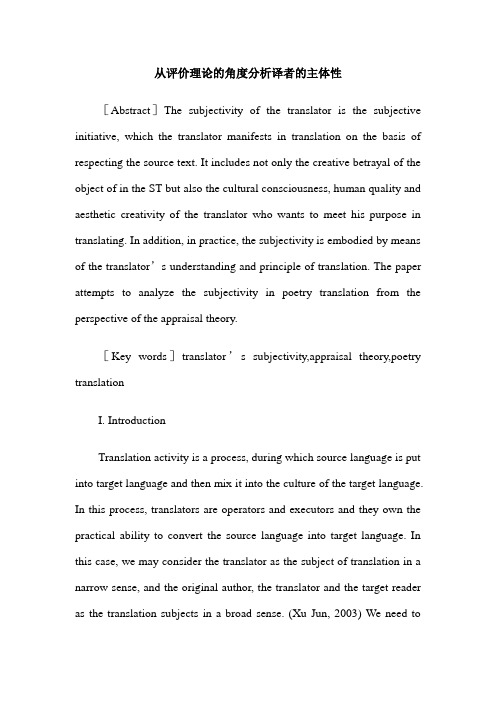
从评价理论的角度分析译者的主体性[Abstract]The subjectivity of the translator is the subjective initiative, which the translator manifests in translation on the basis of respecting the source text. It includes not only the creative betrayal of the object of in the ST but also the cultural consciousness, human quality and aesthetic creativity of the translator who wants to meet his purpose in translating. In addition, in practice, the subjectivity is embodied by means of the translator’s understanding and principle of translation. The paper attempts to analyze the subjectivity in poetry translation from the perspective of the appraisal theory.[Key words]translator’s subjectivity,appraisal theory,poetry translationI. IntroductionTranslation activity is a process, during which source language is put into target language and then mix it into the culture of the target language. In this process, translators are operators and executors and they own the practical ability to convert the source language into target language. In this case, we may consider the translator as the subject of translation in a narrow sense, and the original author, the translator and the target reader as the translation subjects in a broad sense. (Xu Jun, 2003) We need toconsider the roles of all the subjects in a broad sense in the translating process, instead of focusing only on the role of the translator. It is clear that the translator’s subjectivity and translation’s subjectivity are not the same. The present paper will focus on translator’s subjectivity.Ⅱ. Literary Review2.1 Research backgroundIn 1981, in Beyond the Process: Literary Translation in Literature and Literary Theory, Lefevere argued that literary system do not occur in a vacuum. He begins in the article not just look at lexical shifts and the introduction of literary devices in translation, but to also ask questions about the ideological pressures on the translator and strategies that the translator has for influencing the intellectual milieu. (Gentzler, 2004: 137) In order to show how the ideological component limits literary discourse, he introduced the concept of the “refracted text”, by which he means “texts that have been processed for a certain audience (children, for example), or adapted to a certain poetics or a certain ideology.” (Gentzler, 2004: 137) Translator’s subjectivity is highlighted in the above expression, in order to process some information, subjective factors, such as the translator’s personality, experience, competence and etc must be involved.Another scholar we must mention is Lawrence Venuti contributed a lot to making the invisible translators visible and making them go from the background to foreground. As for invisible, he claims that the translators tend to be self-effacing in their work, denying their own voice in favor of that of the author/or the prevailing styles in the receiving culture, and that in translation criticism, scholars tend to ignore the decisions and mediations of the translators, commenting instead as if they have direct access to the original author. Translators are judged to be successful when they read “fluently”, giving the appearance that they have not been translated (Venuti, 1992: 3-5). Instead, Venuti finds every act of translation transformative and creative, seldom transparent, invariably interpretive. Translations are complex texts full of intertextual connotations and allusions containing multiple discourses and linguistic materials, giving translators various choices to support or resist predominant literary and ideological views (Gentzler, 2004: 38).2.2 Current situation in ChinaDiscussions on Translator’s subjectivity began in China in 1990s and flourished later. In 1992, Wang Shouren published an article On Translator Being Creator in the Chinese Translator’s Journal. He claimed that we consider translator as a creator because he created a new “language reality” according to source text. (Wang Shouren, 1992: 45-46)Yang Wuneng (2003:10-13), indicated that translator should be regarded as the subject of translation just as writer is the subject of writing. And that translator’s right should be respected and protected. At last, the focus of translation study should be shifted from the discussion of principle, criteria and strategies to the translator’s subjectivity.Another important person in this field is Xu Jun. In 2003, he published his article Creative Treason and the Establishment of Translational Subjectivity (Xu Jun, 2003: 6-11), in which he discussed the dialectical relationship of “fidelity” and “treason”. He noted that stupid “fidelity” might lead to real “treason”, while clever “treason” might cause true “fidelity”. The value of “creative treason” means that we acknowledge the translator’s creativity. The translator’s subjective awareness refers to a kind of self-conscious personal awareness and a kind of creative awareness. Xu Jun continued to discuss the question “who is the subject of translation?” in this article. He argued that as for the definition of the subjectivity of translation, we must take the subjective role of the author and the reader into account, but it was the translator who existed in the central position as a subject.On the basis of former research, we may know that translator is the subject of translation. Besides, translator plays a dynamic, creative and initiative role in translation. And that, to some degree, the version oftranslation is determined by the translator’s individual likeness, preference, personality, experience, competence and and so on. At last, translator’s subjectivity cannot be displayed freely, and the translator must show “adequate respect to the source text”.Ⅲ. The Analysis of the Translator’s Subjectivity with theAppraisal Theory3.1 An introduction to appraisal theoryAppraisal theory is concerned with the linguistic resources by which a text/speaker comes to express, negotiate and naturalize particular inter-subjective and ultimately ideological positions. Within this broad scope, the theory is concerned more particularly with the language of evaluation, attitude and emotion, and with a set of resources that explicitly position a text’s proposals and propositions interpersonally, which may be put into the analysis of translation.3.2 The analysis of translator’s subjectivity in poetry translation with the appraisal theory《天净沙·秋思》马致远枯藤老树昏鸦,小桥流水人家,古道西风瘦马。
- 1、下载文档前请自行甄别文档内容的完整性,平台不提供额外的编辑、内容补充、找答案等附加服务。
- 2、"仅部分预览"的文档,不可在线预览部分如存在完整性等问题,可反馈申请退款(可完整预览的文档不适用该条件!)。
- 3、如文档侵犯您的权益,请联系客服反馈,我们会尽快为您处理(人工客服工作时间:9:00-18:30)。
(申请文学硕士学位论文)培养单位:外国语学院学科专业:外国语言学及应用语言学研 究 生:谢 佑 芬指导老师:魏万德 教授2004年4月On the Subjectivity of the Translator 谢佑芬武汉理工大学分类号 密 级 UDC学校代码 10497学位论文题目译者主体性研究英文题目 On the Subjectivity of the Translator研究生姓名谢佑芬姓名魏万德职称教授指导教师单位名称外国语学院邮编430070申请学位级别硕士学位专业名称外国语言学及应用语言学论文提交日期 2004年4月论文答辩日期学位授予单位武汉理工大学学位授予日期答辩委员会主席评阅人2004年4月中文摘要译者是翻译的主体,也是民族文化建构的重要参与者,然而翻译主体在中国文化多元系统中长期遭到了遮蔽,出现了译者文化地位边缘化的现象。
随着翻译研究的“文化转向”,翻译主体研究得到应有的重视,译者的特殊文化身份和翻译主体地位逐渐突显了出来。
在前人研究的基础上,本文分析了中国文化语境下译者边缘化文化地位的根源,并对翻译研究中的文化转向进行了回顾,结合目前译者研究现状进而提出了译者主体性研究的问题。
本文澄清了关于翻译主体的两种不同理解,探讨了译者主体性的内涵,指出译者的主体性是指作为翻译主体的译者在尊重翻译对象的前提下,为实现翻译目的而在翻译活动中表现出的主观能动性。
同时,本文还进一步分析了译者主体性的三个特征:译者的目的性、译者的受动性以及译者的创造性,从而深入了对于译者主体性内涵的理解。
此外,本文还结合阐释学、文化翻译理论、读者反应论、互文理论以及主体间性理论,从翻译的过程、译者的译入语文化意识和读者意识、译作与原作以及译作与译入语文学的互文关系、译者与原作者和读者的主体间性关系四个方面探讨了译者主体性的具体表现,以期深化译者主体性的研究。
通过对译者主体性的内涵、特征及表现的探讨,本文最后提出在翻译活动中译者既要有创造意识又要有自我克制意识,同时指出要进一步理解翻译批评的标准和原则,以促使翻译实践和翻译研究的更加深入发展。
关键词:译者, 翻译主体, 译者主体性, 创造性AbstractThe translator is the subject of translation and an important participant in the construction of a national culture. But the subjectivity of the translator has long been obscured, which results in the marginalized cultural status of the translator. With the “cultural turn” in translation studies, proper and increasing attention has been paid to the cultural identity and subject status of the translator.The present paper, based on a survey of the previous studies on translation, and of the retrospect of the “cultural turn” in translation, addresses the subjectivity of the translator and explores the connotation, characteristics and manifestation of the subjectivity of the translator in an attempt to further the research on translational subjectivity.In chapter Ⅱ, a tentative effort is made to explain the connotation of the translator’s subjectivity. Then the characteristics of the translator’s subjectivity are elaborated from three aspects to further explain the connotation: Every translator has his own subjective intention in the purposeful activity----translation. But the subjectivity of the translator is not arbitrary, which must be restricted by all kinds of subjective and objective factors. The translator must give full play to his creativity so as to achieve the translation ends. Furthermore, in light of several theories such as Hermeneutics, Cultural Translation theory, reader’s response theory, intertextuality theory and inter-subjectivity theory, the subjectivity of the translator is further explored through analyzing its manifestation in the translation process, in the translator’s consciousness of the target language culture and readers, in the intertextual relationship between the target text and the source text, the target text and the target literature, and in the inter-subjectivity of translation between the translator, the author and the reader.At the end of this paper, the author puts forward two suggestions: that the translators’ consciousness of creativity shall be integrated with their self-restraint; that translation criteria and principles shall be further understood in hope of promoting the development of translation practice and studies.Key Words: translator, the subject of translation,subjectivity of the translator, creativityContentsIntroduction (1)Chapter Ⅰ Visibility of the Translator’s Subject Status (6)1.1 The Marginalized Cultural Status of the Translator (6)1.2 The Cultural Turn (9)1.3 Visibility of the Translator’s Subject Status (11)Chapter Ⅱ Connotation of the Subjectivity of the Translator (15)2.1 The Subjectivity of Translation (15)2.2 The Subjectivity of the Translator (16)Chapter Ⅲ Characteristics and Manifestation of the Subjectivity of the Translator (19)3.1 Characteristics of the Subjectivity of the Translator (19)3.1.1 Skopos of the Translator (19)3.1.2 Restrictions on the Translator (23)3.1.3 Creativity of the Translator (26)3.2 Manifestation of the Subjectivity of the Translator (35)3.2.1 In the Translation Process (36)3.2.2 In the Translator’s Consciousness of the TL Culture and Readers413.2.3 In the Intertextual Relationship between the TT and the ST, the TTand the Target Literature (47)3.2.4 In the Inter-subjectivity of Translation (49)Chapter Ⅳ Reflection on Translation Research (52)4.1 Uniting the Translator’s Consciousness of Creativity and Self-restraint (52)4.2 Further Understanding of the Translation Criteria and Principles (54)Bibliography (57)Acknowledgements (60)On the Subjectivity of the Translator IntroductionFor a long time, translation studies have put too much emphasis on the nature, criteria and techniques of translation, exploring “how translation is practiced” both at home and abroad. However, systemic studies of the practitioner of translation----the translator have not been adequately performed. The previous research conducted are mainly focused on the introduction of translators’ translation activities and translation viewpoints, but translators’ cultural orientation, aesthetic consciousness and personalities as well as the influence of their translations on the target culture (TC) have not drawn enough attention.The cultural turn in Translation Studies in the West since the 1970s has brought about new dimensions and approaches. With the growth of the descriptive translation in the 1970s and 1980s, and later as the culture-oriented translation studies prevailed, the translator’s subject role in the act of translation gradually became visible. The influence of ideology and literary concepts on the translation at a particular time is mainly manifested through particular translators. On the contrary, translators’ choices of translation materials and strategies may reflect the social and cultural contexts in a particular era. Therefore, it’s necessary to conduct research on translators themselves in order to reveal the relationship between translation and the target culture. We can say that the translator’s subjectivity was discovered thanks to the cultural turn in translation studies. Besides, the target-oriented approach resulting from this shift brings the cultural identities and roles of translators in the translation process to the foreground. Therefore, their1subjectivities including their cultural and aesthetic tendencies have become necessary and important research subjects for translation researchers.Though studies on translators in China claim a long history, a systemic study of the translator-oriented approach did not start until the 1980s. In recent years, the translator’s subjectivity has begun to draw greater attention, which can be seen in the papers of Tian Debei(2000), Zha Mingjian (2003), Yuan Li (2002) and Xu Jun (2003). Tian’s paper discusses the translator’s roles as a reader, a creator, a writer and a researcher. In Zha’s opinion, the translator is the main role of the translation subjects, with the others are the author and the target text reader. Yuan thinks that only the translator is the translation subject. Xu recommends paying much more attention to the study of translators, not only their important roles but also their ideas and opinions. Compared with traditional translation studies, these researchers examine the translator from new perspective and obtain more scientific understanding of the role the translator played in translation activity.While based on the result of the previous studies on the translator, this paper takes the discussion of the subjectivity of the translator in literary translation as a central task. The purpose is to reveal the significance of the translator in translation for cross-cultural communication.There are main four chapters included in this thesis. The exploration begins with the retrospection of the marginalized cultural status of the translator in the first chapter, and analyzed two main reasons that result in the low status of the translator, that is, the subjectivity of the translator is obscured in the strong sense of self-centeredness of Chinese culture and in the traditional translation views. And then the cultural turn of translation studies is introduced to provide the background in which the translator study has begun to draw great attention. Some researchers gradually recognized the subject2status and special cultural identity of the translator, which makes it possible and necessary to conduct researches on the subjectivity of the translator.In chapter two, the comprehension of the subjectivity of translation is clarified, and then the subjectivity of the translator is explained in detail.In chapter three, study of the characteristics and manifestation of the translator’s subjectivity is the focus of the whole paper. The characteristics of the translator’s subjectivity are discussed from three aspects. First, the skopos of the translator. According to the Skopostheorie, translation is purposeful creativity; every translator has his own particular intention. And the process of translation is actually the process of the translator’s choice and decision. When choosing what to translate and how to translate, the translator inevitably conceives some subjective ideas----the translator has his own attitude toward the source text (ST) and the author, and he can presuppose the “intended reader” and adopt different attitudes to the target culture according to his own purpose. However, the subjectivity of the translator is not arbitrary, it is usually restricted by all kinds of subjective and objective factors such as the differences between languages and cultures, the translator’s individuality, specific translation views and strategies in a certain era, and all these may exert certain influence on the translator. Limited by all kinds of factors, the translator has to work creatively in order to achieve his translation purpose. Thus it constitutes the third and most important characteristic of the translator’s subjectivity----the creativity of the translator, which is manifest in various translation works. Translation, as we all know, is a special kind of creation.In the second part of Chapter Three, the manifestation of the translator’s subjectivity is explored in detail too. First the translator’s subjectivity manifests in the translation process, which is the most evident. In this process, the translator must bring his multiple identities----as reader, interpreter and3writer into full play. The translator exchanges view with the author and the source text, makes full use of his aesthetic ability and imagination to concretize the indeterminacies and blankness in the ST. When coming to the stage of presentation, the translator has to reproduce not only the meaning but also the aesthetic information and the flavor of the original. Second, the translator’s subjectivity manifests in the translator’s consciousness of the TL (target language) culture and readers. Since every translation activity proceeds from a certain cultural purpose. According to his awareness of the needs in the TC, the translator may take translation to strengthen certain ideology or literary view, or subvert the existing cultural or literary form for reform purpose. The translator’s consciousness of the TL culture is also embodied in his consciousness of the “intended readers”.In order to make the translation accepted in the TC so as to achieve his translation ends, the translator has to concern about the readers’ horizon of expectation and adopt corresponding translation strategies. Third, the translator’s subjectivity manifests in the intertextual relationship between the target text (TT) and the ST, the TT and the target literature. The translated work is actually an “afterlife” of the ST with independent value. So the TT isn’t subordinate to the ST, but an intertext of the ST. As the TT enters into the target culture, it will be part of the target culture and will form an intertexual relation with the target culture. Fourth, the translator’s subjectivity manifests in the inter-subjectivity of translation. The translator and the author coexist in the translation process; they conduct a dialogue on translation and finish the translation task together. So the translator is not subordinate to the author but deserve an equal status to him. Besides, the translator’s cultural purpose that contained in the TT including the preface and postscript of the TT needs to be understood and accepted by readers in the TC.4Through the exploration of the translator’s subjectivity, two suggestions are put forward in the last chapter, i.e. to unite the translator’s consciousness of creativity and self-restraint, and to further understand the translation criteria and principles, hoping to promote the translation practice and translation studies in the future.5Chapter I Visibility of the Translator’s Subject Status 1.1 The Marginalized Cultural Status of the TranslatorTranslators are important participants in the construction of a nationalculture, and have contributed a great deal to the development and dissemination of human culture. However, they have failed to obtain the position that they deserve as subject of translation. We can see their “marginalized status” from the following metaphors, such as “mouthpiece”, “matchmaker” “craftsman”, “servant with two masters”, “traitor” “fettered dancer”, “translating machine”. The various descriptions of translators just reflect the images of translators in people’s minds, which manifest the nature and difficulties of translation on one hand, and reflect the public’s comments on the value of translation and translator on the other hand.Since the marginalized cultural status of the translator was formed over a long time in cultural development and traditional translation studies. Here we can explore this problem in accordance with the Polysystem theory, in the hope of shedding light on the reasons that resulted in the marginalized status of the translator in Chinese cultural context.In the global cultural polysystem, Chinese culture has a long distinct history, and enjoys powerful position most of the time, that is, Chinese culture influenced other cultures more than it was influenced in turn. Therefore, it was difficult for foreign cultures to participate in the “Primary mode” construction of Chinese culture. (Zhang Nanfeng, 2001). The powerful position of Chinese culture led to a strong self-centered cultural concept. Three translation climaxes have appeared in the history of China, i.e. large-scale translation of Buddhist works in the ancient times; translation of works of natural sciences,social sciences and humanities in early modern times, and translation of works6of literature and science and technology in contemporary times. As we all know, these three translation activities have had far-reaching influence on the development of Chinese culture. However, these three cultural introductions on a large scale all were conducted under the dominion of self-centered Chinese culture. “Cultural filtering and appropriation” (Zha Mingjian, 2003) were made when foreign cultures were introduced to China.Although translational culture has greatly enriched Chinese culture, by contributing to the construction of subjective culture, with an extremely strong sense of self-centeredness, it has been difficult for people to consider translation as an indispensable part of the subjective culture development. Importance attached to the translator’s contribution to the Chinese culture and his role as a creator has been far from adequate.In addition, the subject of translation was obscured by traditional views of translation. Various descriptions of translators mentioned above, also mirrored the traditional views of the translator, which regarded translation as transformation between languages, and believed that the study of translation was to explore how to perform translation and how to achieve excellent translation (Xie Tianzheng, 2002). Since translation was considered to be a transfer between languages, translator was regarded accordingly as “skilled worker”, “translating craftsman”, “translating machine” or even “cultural tool”. So the translation studies on translators including translation criticism are confined to comment on their techniques as well as gains and losses at language level, rather than evaluate their contributions to the culture and literature from cultural and literary perspectives.There are many kinds of ideal translation criteria in traditional translation studies. Apart from the criteria of “faithfulness, expressiveness, elegance”, the most influential criteria is “transmigration”,which requires that the translated text should produce the same effect as the original text when read. The7translator must overcome the difficulties caused by discrepancies between languages to enable the translated text to be read as fluently as the original text and at the same time be true to original style. The counterpart of “transmigration” in the west is the view of the “invisibility of the translator/translated text”. The “invisibility theory” considers the ideal translated text should be like a piece of glass, which makes the readers of a translated text to believe that they are reading the original text. Actually, the “transmigration” and the view of the “invisibility of the translator/translated text” are both idealized translation criteria that cannot be entirely achieved by translators. However, translators are often placed in an awkward situation and translated works are usually regarded as a mimics or substitutes, under the condition that these two translation criteria are extremely advocated.The other prevailing opinion in the traditional translation study is that the value of translation is inferior to the original act of composition/creation. In this view, translation is a form of imitation, and a translated text is the copy of original text and lack of creation. Even though some people concede that translation is also a creative process, but they consider it to be a “parasitical art” and believe that its creative and literary value cannot be compared to that of the original work.First, translators are supposed to produce transparent versions that aim at utmost fidelity or equivalence. The consciousness of invisibility is typically represented in George Mountin’s Les Bells Infideles “The ideal target text should look like a piece of glass, which is so transparent that readers cannot feel its existence.” (1995:111) Translators feel honored if critics do not feel their existence, because their absence implies their success.Second, translators are considered as servile lackeys to the authors. For instance, John Dryden maintains that translators should follow whatever the original author does and compares them to slaves who toil in the master’s field,8and whose harvested gains belong to masters. Yang Jiang, a well-known Chinese writer and translator, also holds the similar view. She says that translators are at the command of the ST cannot make their own decisions. They have to attend to two lords at the same time: one is the source text; the other is the target readership.From the above analysis, it is clear that the translator was obscured in the strong sense of self-centeredness of Chinese culture and traditional view of translation, which led to the marginalized cultural status of the translator. As a result, the research on the translator was neglected in translation studies. Only if the nature and cultural function of translation were fully recognized, the translator, as the subject of translation will become visible and the translator study will be put on the agenda of translation studies.1.2 The Cultural TurnSince the 1970s and 1980s, a group of literary translators, such as Hermans, Andre Lefevere, Bassnett, and Venuti, have oppugned the linguistic approach and advocated the development of translation studies as an independent academic discipline. Postmodernism theories, including Deconstructionism, Feminisism and Postcolonialism, mushroomed in the field of translation studies. Since the late 1980s, the translation studies turned to be cultural-oriented, which brought about new dimensions and approaches. Translation is understood as a cultural rather than a linguistic transfer, and the act of translation is no longer a “transcoding” from one context into another, but an “act of cultural communication”. Hans J. Vermeer has argued that transformation is first and foremost a “cross-cultural transfer”. Thus, the translator must not only be bilingual but effectively bicultural as well. Translation studies in descriptive perspective are more concerned with the9“function of the target text” rather than the “prescriptions of the source text”, and tend to answer such questions as what can the translation version do? How can they circulate and arouse echoes? The target-oriented approach, resulting from this shift, put the cultural identities and roles of translators in the foreground. A number of scholars of translation studies have thus taken a “cultural turn”, focusing on the “external politics” of translated literature, and accounted for “the macro-factors involved with the function of the literary system”, for the constitutive factors involved with any cultural event.Translation studies also turn to the discussion of the relationship between translator and a target culture, especially the impact of translation on a target culture. Last but not least, the “cultural turn” in translation studies approaches translation as an activity powerfully affected by its socio-political context and the demand of the translational culture.Many target culture oriented translation theories and schools are formed during the “cultural turn”, among them the most influential are the polysystem school represented by Itamar Evan-Zohar and Gideon Toury and the manipulation school represented by Andre Lefevere, Susan Bassnett and Theo Hermans. Polysystem theories provide the theoretical framework for TC-oriented translation studies, while manipulation theories offer a new perspective for the cognition of translation.Developed in the 1970s, the polysystem hypothesis was originally designed as a theoretical framework for the descriptive study of literature and language in their cultural context. The school of Polysystem stretched the study of Early Translation Studies, and believed translation studies should be put in a larger literary, social and cultural frame, Itamar Evan-Zohar and his colleague Gideon Toury presupposed translation literature was part of the target literature and put forward the Polysystem Theory and important concepts of translation norms, inaugurating a new-brand dynamic paradigm of10literary translation study. The theorists of school broke through the boundaries of language in their study. Israeli scholar Gideon Toury gave a wide definition of “a translation will be any target language text which is presented or regarded as such with the target system itself, on whatever grounds.”These two translation schools both emphasized the role of the translator in the translation process and the visibility of the translator. The characteristics of these new translation theories can be concluded in two points: firstly, translators are active participants; secondly, the focus has moved from the “meaning” itself to the meaning-producing field.1.3 Visibility of the Translator’s Subject StatusAfter the “cultural turn”, translator’s status is promoted to a great extend. Translators are no longer considered to be inferior to the author of the original, instead they are indispensable participants in the process of translation, who act not only as receptors of the source text but producers of a target text. Their crucial roles are recognized as follows.Hermeneutics emphasizes the translator’s active interpretation of literary texts. According to this theory, the translator is not a passive recipient of meaning but an active and creative subject in creating meaning. Translators cannot be excluded from their pre-understanding structure in the complex process of interaction with the source text. Inevitably a translator will feed his own beliefs, experience and attitudes into the processing of a text, so that any translation, to some degree,will reflect the translator’s own mental outlook and their idiosyncracies despite of impartial intention.Scholars in translation studies have shed new light on the status of the translator, who has increasingly become more empowered and respected. One representative, Theo Hermans, holds that translation is a type of original11。
